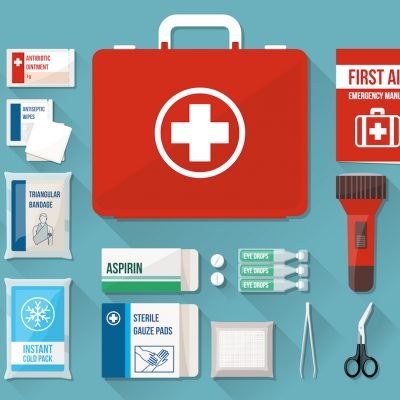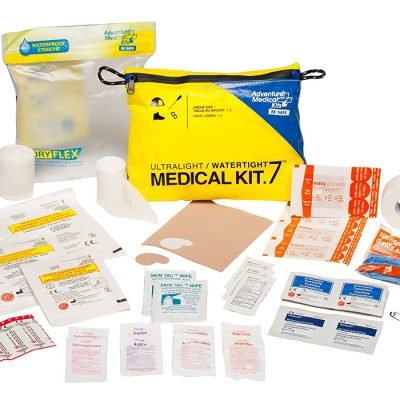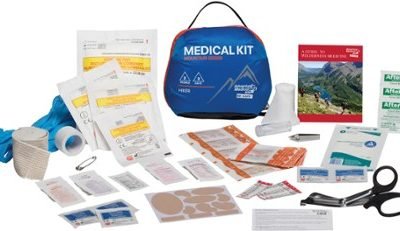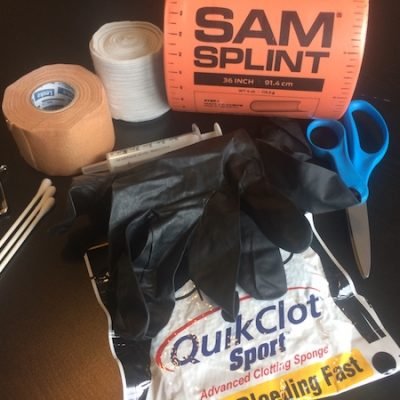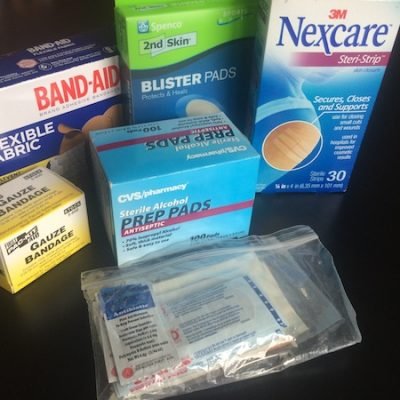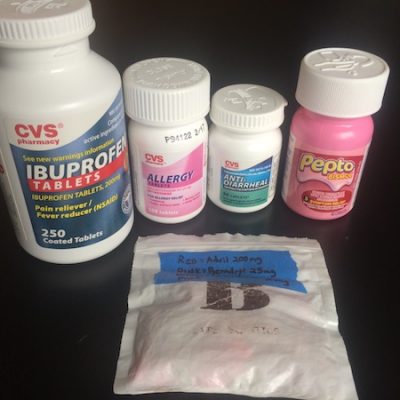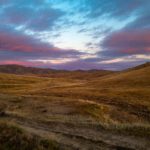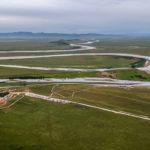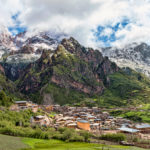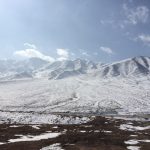
- Medical Situations an Outdoor First Aid Kit Helps With
- Specific Considerations for Your Trip
- Building Your Own Customized First Aid Kit
- Checklist of Items in a Backcountry First Aid Kit
- Recommended Popular Commercial Kits to Start With
- Other Resources For Building Your Own First Aid Kit
Medical Situations an Outdoor First Aid Kit Helps With
Before we even dive into the nuts and bolts of building out a great kit, it’s important to know the most common backcountry injuries and medical emergencies that you can handle on your own. I’ve written more extensively about those before but here’s a brief overview of what a first aid kit can help you prepare for.
Cleaning Wounds and Protecting Skin
In the wilderness, you’re likely to be working with fire and using sharp, primitive tools that you might not be totally familiar with. Cuts, scrapes, and burns are all relatively common injuries that can usually be treated without much fuss.
The majority of cuts you’ve gotten in your life likely stopped bleeding on their own, or with a bit of direct pressure and elevation. A good wilderness first aid kit will have items to help you control someone else’s bleeding (gloves and gauze) as well as tools for cleaning deeper cuts and keeping them from getting infected.
Supporting Injured Joints and Fractures
Especially when carrying a heavy backpack over rugged terrain, one bad step or a poorly timed fall can lead to fairly debilitating musculoskeletal injuries. These are the kinds of injuries that can not only ruin a trip, but make it difficult to get back to civilization on your own.
Having a few key items on hand can make a big difference in dealing with injured joints or broken bones, and can prevent smaller injuries from getting worse over time.
Maintaining Normal Body Functions
While issues like diarrhea, mild fever, seasonal allergies and low blood sugar are annoying but easily treatable in the front country, anything that gets you laid up and prevents you from hiking out can become a serious issue in the backcountry.
If you find yourself struggling with these issues on a backpacking trip, some simple over-the-counter medications can make a huge difference in your ability to get back to the trailhead safely.
Relief for Pain, Soreness and Discomfort
While not the most heroic form of first aid, sometimes offering a few advils or a tums can go a long way to improving someone’s experience while they’re out on a trip.
Being able to treat blisters can make you seem like a super hero to someone who has been struggling with one all day.
Specific Considerations for Your Trip
When preparing your gear list for a trip, you should already be thinking about key packing considerations like group size and expected weather conditions.
It’s important to also think about the hazards that each trip presents, in terms of first aid situations you’re likely to encounter. Here are a few questions you should ask yourself before each trip.
- Are there members of your group that are older, out of shape, or otherwise at risk for a heart attack?
- Is there anyone on the trip with known, severe allergies that would be at risk of anaphylaxis?
- Are there venomous creatures like snakes or spiders in the area you’ll be hiking through?
- Are you at risk of puncture or gunshot wounds on a hunting trip, or a hike during hunting season?
- Could the weather conditions lead to heat or cold related injuries?
- Will there be ticks, leeches, mosquitoes or other small biting pests you’ll have to contend with?
The answers to these questions will often vary from trip to trip, but it’s important to consider each of them to ensure you’re prepared for the situations you’re likely to face.
Building Your Own Customized First Aid Kit
We’ll talk more about pre-made, commercially available kits later in this article, but I’d really recommend building your own (or heavily customizing a purchased one) for a few key reasons.
Cheaper in the Long Run
There’s often a huge markup on store-bought, pre-packaged kits. You’re paying for the brand name and the heavy bag that it comes in. Each of the materials can often be purchased for much cheaper online or at your local pharmacy.
This is especially important if you think your first aid kit will be getting some decent use over the years. It’s much easier to buy most items in bulk, store them in your medicine cabinets and then restock your kit whenever you need to.
Easier to Customize
While most kits make a decent attempt at preparing for the generic problems a hiker is likely to face on the trail, often they don’t really hit the mark. I’ve usually found that most kits include way too much gauze and not nearly enough ibuprofen, for example.
Building your own kit also forces you to think about your own personal needs and those of your group. You might be more likely than the average hiker to be dealing with allergies, chronic joint pain or blood sugar issues.
You Know What’s In It
I can’t tell you the number of times I’ve seen someone hike for miles with blisters or a headache or some other easy-to-treat issue, without realizing they’ve been carrying the solution to their ailment on their back the entire time.
Build your own kit forces you to consider each of the elements that you’re carrying, and makes you much more likely to recall and use them in the appropriate situations.
Keeping everything in a sturdy, clear ziplock freezer bag is fine. Just make sure it’s well labeled so that someone else can find it in your pack in an emergency.
Checklist of Items in a Backcountry First Aid Kit
I tried to err on the side of including more stuff rather than leaving something out that might be important for your trip. You likely won’t need all of these items for every trip, but I’ve put asterisks next to essential items – the ones that I always carry.
Medications

Pills weigh almost nothing and are easy to keep in a small baggie. I toss a few grains of rice into my pill bag to help soak up any moisture that might make its way in. Make sure to take stock of your pill bag before each trip so don’t run out of anything at a bad time.
- Ibuprofen (Advil)* – Common for headache and pain relief as well as for reducing fever and inflammation. Affectionately known as “Vitamin A”. 💊
- Diphenhydramine (Benadryl)* – Antihistamine for allergy relief and early anaphylaxis. Can also be taken as a sleeping pill.
- Loperamide (Immodium)* – Anti-diarrhea pill that can be essential for getting yourself out of the woods if you catch a bug due to bad food or poor hygiene.
- Epinephrine (Epi-pen) – My WFR instructor described an epi-pen as pound for pound, the most lifesaving piece of gear you can carry if someone in your group has severe allergies.
- Aspirin – Good to have on hand if someone in your group is likely to suffer a heart attack as it can decrease the associated risk of death.
Wound Care

This is the stuff that usually takes about about 90% of a hiking first aid kit. The goal of these items is to help you stop the bleeding, control infections and promote healing.
In a pristine hospital setting, anything that goes on or into an open wound must be sterile. In the backcountry, you’re unlikely to have that luxury, so “clean” will usually suffice. Make sure you follow up with any sketchy wounds when you get home or if they start showing signs of infection.
- 3” Fabric Band Aids* – Your normal, everyday bandaid for protecting most minor cuts and scrapes. The fabric ones breath well and stretch with your skin as you move, so they’re more likely to stay on and not get gross.
- Triple Antibiotic Ointment (Polysporin)* – Once a wound is no longer bleeding and has been flushed with water, add some of this ointment to help prevent infections and promote healing.
- 2” Roll of Gauze* – A lot of off-the-shelf kits contain individually-packaged squares of gauze in various sizes, which creates a lot of waste and extra weight. A 2” roll of gauze packs down small and lets you use the right amount for any given wound.
- Alcohol Pads – Use these for cleaning the skin around a wound before dressing it.
- Quickclot Dressings – A vacuum-sealed packages of gauze impregnated with a hemostatic agent, they’re designed to be used on cuts or punctures with extra-strength bleeding to bring it under control quickly.
- Nexcare Steri-Strip – These are long, thin pieces of tape designed to be laid across a wide cut to pull the skin together on both sides. They basically function like stitches that you can apply yourself to keep a wound closed.
- Spenco 2nd Skin Blister Pads – A small pad that sticks well and protects blisters and small burns, allowing them to heal faster and with less discomfort.
- Irrigation Syringe – You can get a small 5ml syringe for free from your local CSV pharmacy if you ask nicely. These are useful for pushing clean water into deep lacerations to help flush out the nasties.
Two other pieces of wound care gear that are commonly mentioned that I would not recommend:
- Sheet of Moleskin – It’s really only useful for one, non-essential job – padding around blisters, and it takes too much fiddling to cut out a piece that is the correct size and get it to actually sticks to your skin. Learning how to safely drain a blister will relieve the pressure with a lot less fuss.
- Israeli Bandage or Tourniquet – I really struggle to come up with a situation outside of a battlefield where this would be useful. You’d have to have a high chance of losing a lot of blood from an extremity for it to justify its own weight in your pack. That said, it might be good for hunting trips.
Other Essentials
 As a general packing philosophy, I tend to prefer simpler items than can perform multiple jobs rather that specific pieces of gear that can only do one thing. With that in mind, here are a few extra pieces of gear in my kit.
As a general packing philosophy, I tend to prefer simpler items than can perform multiple jobs rather that specific pieces of gear that can only do one thing. With that in mind, here are a few extra pieces of gear in my kit.
- Leukotape* – The best thing I’ve found for sticking to skin while not being painful when you eventually want to remove it. It breathes better than duct tape and sticks better than medical or athletic tape. It’ll last you the entire trip back to the trailhead and then some.
- Nitrile Gloves* – These should be standard in any kit but unfortunately aren’t. Nitrile protects you from coming in direct contact with another person’s blood and fluids while you’re working on them. Ask for a few pairs the next time you’re visiting the doctor.
- 2” Elastic Bandage* – Can be easily fashioned to support an ankle or knee injury, if the joint is still usable. If it’s not usable and you need to make a splint, this is also very handy. I prefer the ones with velcro closures over those bendy metal pieces that don’t last.
- Tweezers – Can be used for any task where you need fine motor control and precision, like removing a splinter or pulling off a tick.
- SAM Splint – A stiff but packable splinting material commonly carried by many search and rescue teams. Useful for stabilizing and supporting injuries.
- Snub-nose Scissors – If your pocket knife doesn’t already have a pair, a small set of scissors is useful for trimming gauze, opening packaging and removing clothing in a pinch.
- Safety Pins – I carry a few in case of gear repair issues anyways, but they’re also great for draining blisters safely.
- Q-Tips – Useful for applying ointment deep inside a cut without sticking your fingers into it. Also useful for cleaning ears and noses as well as gauging a person’s skin’s touch sensitivity.
- Triangular Cravat – Basically like a giant bandana that you can use to help fashion a splint or pack into a wound. This is easily improvised with the bandanas and clothing that you’re likely already carrying.
Recommended Popular Commercial Kits to Start With
While there are many benefits to building your own kit from scratch, it can be intimidating if you’re not sure where to begin. Instead, it might be better to start with a pre-built commercial kit and customize that to your needs – tucking the excess supplies it comes with into your medicine cabinet and bolstering the kit where it’s lacking.
Adventure Medical Kits Mountain Series Hiker Medical Kit
Weight: 7oz
Price: Click for Price & Availability
The Adventure Medical Kits Mountain series is a great light-and-fast set of first aid kits that don’t skimp on essentials. Their Hiker Medical Kit has 3 pairs of nitrile gloves, a stretchy elastic wrap bandage as well as roll gauze, which are all excellent essentials.
The bag itself is lightweight and no-frills, and it also comes with a handy pocket guide to wilderness medicine which can definitely be useful in an emergency situation.
I’d ditch the trauma shears, moleskin cutouts and giant gauze pads for most trips. I’d probably also swap out the fabric tape with some Leukotape and add way more ibuprofen (they only include 4 pills).
This is a great all-around starter kit that’s light and flexible and comes with a bunch of useful items that you can choose to leave at home on specific trips if you’d prefer.
Adventure Medical Kits Ultralight & Watertight .7
Weight: 8oz
Price: Click for Price & Availability
Another great starter kit from Adventure Medical Kits is their Ultralight & Watertight 0.7. This kit is even more compact that the Mountain Series Hiker, ditching the shears and bulky gauze pads, but still includes 1 pair of nitrile gloves, a stretchy elastic wrap bandage and a roll of 2” gauze.
The bag itself is allegedly waterproof, making it a pretty durable package for your kit. However, the slim profile also makes it a challenge to add bulkier items like an epi-pen or scissors, if you needed to toss those in on an occasional trip. It also seems to weigh a bit more that the Mountain Series Hiker kit, despite the “ultralight” name.
I’d remove the moleskin sheet and swap the fabric tape for something that sticks better. The kit also includes some duct tape and safety pins if you need to MacGyver a wound together, but you might already be carrying these staples elsewhere in your backpack already.
This is a good no-frills kit for the minimalist who doesn’t plan on adding much extra gear of their own.
REI Co-op Backpacker Weekend First-Aid Kit
Weight: 9.5oz
Price: Click for Price & Availability
REI has a whole series of their own first aid kits but the Backpacker Weekend First-Aid Kit seems to strike the right balance of gear. It has important essentials like a roll of gauze, elastic wrap bandage, and a wilderness first aid manual. It doesn’t have gloves but it does have an assortment of small creams for burns and stings.
REI seems to tout all of the many labeled pockets in their kits as a way to keep everything organized. However, they add a lot of bulk to the packaging and make it much more difficult for you to reorganize it with your own gear mixed in.
This is a good starter kit for anyone who appreciates the organization and doesn’t plan on customizing their kit very much.
Other Resources For Building Your Own First Aid Kit
All of the advice I’ve given so far is based on my own experiences treating and managing real backcountry medical emergencies, as well as my Wilderness First Responder training.
But don’t just take my word for it.
Whenever you’re putting together something as important as your first aid kit, it’s important to consider multiple sources. Here are a few other great resources to help you think more carefully about what you should bring for you next trip.
“Backpacking First Aid Kit for soloists & groups” by Andrew Skurka
Andrew Skurka is a well-known adventure racer and ultralight backpacker. In this post, he lays out the core first aid essentials he brings as well as group considerations that might add a few more items to his kit.
“Building a Wilderness First Aid Kit” by Wilderness Medical Associates
Wilderness Medical Associates is one of the leading backcountry medicine training providers in the US. In this article, one of their staff members lays out her ideal first aid kit for remote trips.
“First-Aid Checklist” by REI
In this article on the REI blog, they list every possible item you might ever want to include in your kit, including many I intentionally skipped over, like a magnifying glass, mirror, CPR mask and oral thermometer.
“What Items Belong in My Backpacking First-Aid Kit?” by Outside Magazine
A very minimalist perspective from another Wilderness First Responder. He lists the core essentials he takes on every trip.
“Can we talk about First Aid?” on Reddit
If discussions are more of your thing, here’s a great thread on the Wilderness Backpacking subreddit where a bunch of people share what’s in their kits and debate what they feel is necessary.
Ultimately, a first aid kit is just a collection of a bunch of small but essential pieces of gear. It’s a backpacking myth that a survival kit alone will get you out of any situation you get yourself into.
In reality, it takes training and thoughtful decision making to handle backcountry medical emergencies.
If you’re interested in learning more, check out my article on essential Wilderness First Aid skills. I’d also highly recommend taking a weekend-long Wilderness First Aid class in your area.
Article by: Hartley Brody
See more awesome wilderness content here:
https://adventures.hartleybrody.com/
